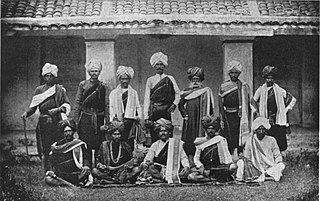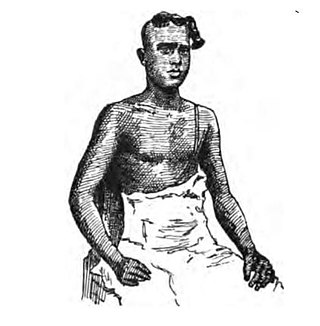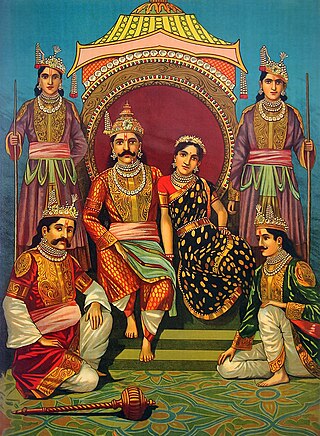L. A. Krishna Iyer | |
|---|---|
| Born | Kerala, India |
| Occupation(s) | Anthropologist Historian |
| Known for | Anthropological writings |
| Children | L.K. Ananthakrishnan, L. K. Balaratnam, L.K. Ramachandran and LK Padmanabhan |
| Parent | L. K. Ananthakrishna Iyer |
| Awards | Padma Bhushan |
Lakshminarayanapuram Ananthakrishna Krishna Iyer was an Indian anthropologist and a writer of several books on the subject. [1] He was the head of the department of Anthropology at the University of Madras and was credited with studies on the tribal and scheduled caste people of Kerala, a work initiated by his father, L. K. Ananthakrishna Iyer, himself a noted anthropologist. [2] Anthropology in India, [3] Social History of Kerala, a two-volume historical study [4] and The Travancore Tribes and Castes, a three-volume account of the tribal people of southern Kerala [5] are some of his notable works. The Government of India awarded him the third highest civilian honour of the Padma Bhushan, in 1972, for his contributions to science. [6] His sons, L.K. Ananthakrishnan,L. K. Balaratnam, is also a known anthropologist. [2] Dr L.K. Ramachandran noted Scientist/ Bio-Chemist/> L.K. Padmanabhan His daughters, L.K. Lakshmi, L.K. Kamalam, L.K. Bhagirathy and L.K. Parvathy.

The Kingdom of Travancore, also known as the Kingdom of Thiruvithamkoor, was an Indian kingdom from c. 1729 until 1949. It was ruled by the Travancore Royal Family from Padmanabhapuram, and later Thiruvananthapuram. At its zenith, the kingdom covered most of the south of modern-day Kerala and the southernmost part of modern-day Tamil Nadu with the Thachudaya Kaimal's enclave of Irinjalakuda Koodalmanikyam temple in the neighbouring Kingdom of Cochin. However Tangasseri area of Kollam city and Anchuthengu near Attingal in Thiruvananthapuram were parts of British India.

The Nair also known as Nayar, are a group of Indian Hindu castes, described by anthropologist Kathleen Gough as "not a unitary group but a named category of castes". The Nair include several castes and many subdivisions, not all of whom historically bore the name 'Nair'. These people lived, and continue to live, in the area which is now the Indian state of Kerala. Their internal caste behaviours and systems are markedly different between the people in the northern and southern sections of the area, although there is not very much reliable information on those inhabiting the north.

The Nair Service Society (NSS) is an organisation created for the social advancement and welfare of the Nair community that is found primarily in the state of Kerala in Southern part of India. It was established under the leadership of Mannathu Padmanaban. The NSS is a three-tier organisation with Karayogams at the base level, Taluk Unions at the intermediate level and a central headquarters operating from Perunna, Changanassery in Kerala. G. Sukumaran Nair is the present General Secretary.

Vokkaliga is a community, or a group of closely related castes, from the Indian state of Karnataka. They are also present in the neighbouring state of Tamil Nadu.

Kotas, also Kothar or Kov by self-designation, are an ethnic group who are indigenous to the Nilgiris mountain range in Tamil Nadu, India. They are one of the many tribal people indigenous to the region.. Todas and Kotas have been subject to intense anthropological, linguistic and genetic analysis since the early 19th century. Study of Todas and Kotas has also been influential in the development of the field of anthropology. Numerically Kotas have always been a small group not exceeding 1,500 individuals spread over seven villages for the last 160 years. They have maintained a lifestyle as a jack of all trades such as potters, agriculturalist, leather workers, carpenters, and black smiths and as musicians for other groups. Since the British colonial period they have availed themselves of educational facilities and have improved their socio-economic status and no longer depend on the traditional services provided to make a living. Some anthropologists have considered them to be a specialized caste as opposed to a tribe or an ethnic group.
The Billava, Billoru, Biruveru people are an ethnic group of India. They are found traditionally in Tulu Nadu region and engaged in toddy tapping, cultivation and other activities. They have used both missionary education and Sri Narayana Guru's reform movement to upgrade themselves.

The Nambudiri, also transliterated as Nampoothiri, Nambūdiri, Namboodiri, Namboothiri and Nampūtiri, are a Malayali Brahmin caste, native to what is now the state of Kerala, India, where they constituted part of the traditional feudal elite. As the highest ranking caste in South India, they owned a large portion of the land in the region of Malabar until the Kerala Land Reforms starting in 1957, and intermarried with the Nair monarchs and aristocracy through Sambandham. This marriage relation between the Nambudiris, who were feudal Brahmin priests, and the Nairs, who were kings and warriors, formed a crucial aspect in the administration (Jenmi) of colonial Kerala.
Diwan BahadurLakshminarayanapuram Krishna Ananthakrishna Iyer (1861–1937) was an anthropologist of British India. He is known for his work among the hill tribes of the western part of Madras province.

Neyyattinkara Vasudevan was a Carnatic music vocalist from Kerala in south India. The Padmasree-winning Carnatic vocalist and disciple of Semmangudi Srinivasa Iyer and Ramnad Krishnan, he combined tradition and innovation in his widely acclaimed career. Vasudevan is famous as being one of the first from the Dalit community to excel in the field which was previously the preserve of the upper castes.

Polyandry in India refers to the practice of polyandry, whereby a woman has two or more husbands at the same time, either historically on the Indian subcontinent or currently in the country of India. An early example can be found in the Hindu epic Mahabharata, in which Draupadi, daughter of the king of Panchala, is married to five brothers.

Kiryathil Nair or Kiriyath Nair is a Kshatriya Nair subcaste, of martial nobility, having performed the functions of Kshatriyas in Kerala, India. This subcaste was among the highest-ranking subcastes of the Nair community along with Samantan Nairs with whom they share a close history. They constituted the ruling elites (Naduvazhi) and feudal aristocrats (Jenmimar) in the regions of Malabar and Cochin in present-day Kerala, India, and have traditionally lived in ancestral homes known as Tharavads and Kovilakams.

Vaikom Satyagraha, from 30 March 1924 to 23 November 1925, was a nonviolent agitation for access to the prohibited public environs of the Vaikom Temple in the Kingdom of Travancore. Kingdom of Travancore was known for its rigid and oppressive caste system. The campaign, led by Congress leaders T. K. Madhavan, K. Kelappan K. P. Kesava Menon, George Joseph, E. V. Ramasamy "Periyar" and was noted for the active support and participation offered by different communities and a variety of activists.
Kumar Suresh Singh (1935–2006) commonly known as K. S. Singh, was an Indian Administrative Service officer, who served as a Commissioner of Chhotanagpur (1978–80) and Director-General of the Anthropological Survey of India. He is known principally for his oversight and editorship of the People of India survey and for his studies of tribal history.

Castes and Tribes of Southern India is a seven-volume encyclopedia of social groups of Madras Presidency and the princely states of Travancore, Mysore, Coorg and Pudukkottai published by British museologist Edgar Thurston and K. Rangachari in 1909.

The Kunchitigas are a community of people from Karnataka, India. They are mostly concentrated in the Tumkur, Bangalore, Mysore, Ramanagara and Chitradurga districts. They are also found in Tamil Nadu.

Holeya are a scheduled caste of India, mainly belonging to present day Karnataka State, Kerala, Maharashtra, Tamil Nadu and also Madhya Pradesh.

Madhva Brahmins, are Hindu Brahmin communities in India, who follow Sadh Vaishnavism and Dvaita philosophy propounded by Madhvacharya. They are found mostly in the Indian states of Karnataka, Maharashtra, Goa, Tamil Nadu, Kerala, Telangana and Andhra Pradesh.
Mulakkaram, literally translated as breast tax, was a poll tax imposed on women belonging to Nadar, Ezhava and other lower caste communities by the erstwhile Kingdom of Tranvancore, and was not applicable to upper caste women of Travancore. The term "breast tax" was used to denote the gender of the person and not breasts per se.

Stephen Fuchs was an Austrian Catholic priest, missionary, and anthropologist who researched the ethnology and prehistory of India. After obtaining a Ph.D. in ethnology and Indology from the University of Vienna in 1950, Fuchs moved to India where he assisted in founding the Department of Anthropology at St. Xavier's College in Bombay. After a brief imprisonment for being misidentified as a German missionary by the British government during World War II, Fuchs founded the Indian Branch of the Anthropos Institute, later renamed the Institute of Indian Culture. Fuchs, because of health concerns, moved to Austria in 1996 and died at the age of 91 in Mödling, Austria.
P. R. G. Mathur was an Indian anthropologist noted for his studies on the indigenous communities in India in general and Kerala in particular. He is also known for his efforts to bring the tribal community in Attappadi and Wayanad in Kerala to the mainstream of society by working among them. He had held several positions in the Anthropological Survey of India. He served the Kerala Institute for Research, Training and Development Studies of Scheduled Castes and Scheduled Tribes (KIRTADS) as its director for more than 15 years.
{{cite journal}}: Cite journal requires |journal= (help)